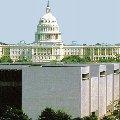One of the world's most popular museums has gotten an upgrade. Washington's National Air and Space Museum has added an observatory where visitors can get a first-hand look at the Sun, the moon, and the planets. With seven million visitors a year, the Smithsonian Institution's National Air and Space Museum may be the world's most popular museum. They have the Wright Brothers' plane and the Apollo moon capsule and lots of other cool stuff. They've got a planetarium, where you can see a simulation of the sky. But they haven't had a telescope that visitors can actually use ... until last week. The museum's new telescope sits under a small dome on the building's terrace. It's a 40-centimeter instrument originally purchased by Harvard University and now on loan to the Smithsonian to coincide with the International Year of Astronomy, which in turn marks 400 years since Galileo first turned a telescope to the heavens. "The availability of this grand piece of equipment will allow any visitor of the National Air and Space Museum to be an active participant in this 400th anniversary," said Ardent Bement, director of the National Science Foundation, which is helping to pay for the new observatory. "We will be able to whisper in wonder at the vastness beyond ourselves, just as Galileo must have done." Dark skies may be best for observing the stars and planets, but the telescope will normally be open only during daylight hours. Nevertheless, Air and Space Museum curator David DeVorkin says you can see a lot during the day.
"We've been looking at Venus, now, for weeks. And see it go through phases. You can see Jupiter. You can see Jupiter's moons. You can see Saturn, Saturn's rings. No problem at all. The moon, craters on the moon.
"And we've seen bright stars," DeVorkin added. "The nicest thing is you can still see their colors. There's enough contrast so that you can tell the difference between a red star and a blue star and show people that stars have colors. All of that you can do during the day." In addition, DeVorkin says that with special filters, you can observe features of the Sun as well.
The new observatory is located amid a cluster of Smithsonian museums, including the newest, the National Museum of the American Indian.
Smithsonian official Roger Brissenden said that's appropriate because of the appeal of astronomy across cultural boundaries. "The American Indians themselves studied the phases of the moon, and for thousands of years used the observations to guide their rituals and the cycles of their crops. So I hope as people from different cultures come together to observe through our telescope, they'll start new conversations about what astronomy means to them, and in this way our telescope may even help break down some cultural boundaries." Brissenden is associate director of the Smithsonian's own scientific observatory. He talked about the wonder of seeing Saturn and its rings through a telescope when he was a 7-year-old boy in Australia.
"So I wonder how many young people will take their first look at the moon, the planets, and the stars through this telescope, and be inspired as I was to become a professional astronomer. And I wonder how many others will be inspired to think about the universe in a new way and follow their own paths to aeronautical engineering or space science or to write, to paint, or to create poetry. I can't wait to find out." Shortly after the opening ceremonies, the telescope got some of its first regular visitors – a group of 11-year-olds from a local school – who possibly will be inspired to be the astronomers, engineers, and scientists of tomorrow.
Art Chimes, VOA News, Washington, DC

